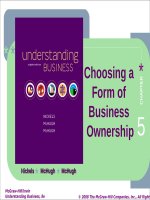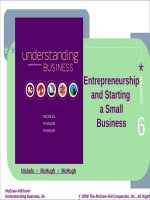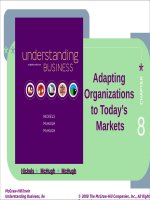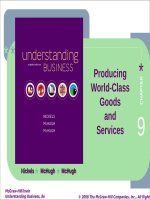Understanding business 11th by mchugh nickels chapter bonus a
Bạn đang xem bản rút gọn của tài liệu. Xem và tải ngay bản đầy đủ của tài liệu tại đây (2.94 MB, 41 trang )
BONUS CHAPTER A
Working
within the
Legal
Environment
McGraw-Hill/Irwin
Copyright © 2015 by the McGraw-Hill Companies, Inc. All rights reserved.
LEARNING OBJECTIVES
1. Define business law, distinguish between statutory and
common law, and explain the role of administrative
agencies.
2. Define tort law and explain the role of product liability in
tort law.
3. Identify the purposes and conditions of patents,
copyrights, and trademarks.
4. Describe warranties and negotiable instruments as
covered in the Uniform Commercial Code.
5. List and describe the conditions necessary to make a
legally enforceable contract, and describe the possible
consequences if such a contract is violated.
A-2
LEARNING OBJECTIVES
6. Summarize several laws that regulate competition
and protect consumers in the United States.
7. Explain the role of tax laws in generating income for
the government and as a method of discouraging or
encouraging certain behaviors among taxpayers.
8. Distinguish among the various types of bankruptcy
as outlined by the Bankruptcy Code.
9. Explain the role of deregulation as a tool to
encourage competition.
A-3
EVE WRIGHT TAYLOR
Miami Heat
• Attended law school at the
University of Indiana and
worked for the LPGA before
heading into the male
dominated NBA.
• With the Miami Heat, Taylor
may be asked for legal advice
on issues regarding the
stadium, marketing, sales, and
playerrelated matters.
A-4
NAME that COMPANY
As a federal government agency, we have a key
role in mergers and acquisitions in the United
States business community. Without our
approval, mergers or acquisitions can be
rejected. For example, we approved the merger
of American Airlines with U.S. Airways, but
rejected a merger between AT&T and TMobile.
Name that organization!
A-5
The NEED for LAWS
LO A1
• Laws are a key part of a civilized society, but
must change with the times.
• Judiciary The branch of government chosen to
oversee the legal system through a system of courts.
• The U.S. courts system is organized at the
federal, state, and local levels.
A-6
TYPES of COURT
LO A1
• Trial courts hear cases of
criminal and civil law.
• Appellate courts hear
appeals from the losing party
at the trial court level.
A-7
TYPES of LAW
LO A1
• Criminal law defines crimes, establishes
punishments, and regulates the investigation and
prosecution of people accused of committing crimes.
• Civil law proceedings cover noncriminal acts
divorce, personal injury lawsuits and more.
• Business Law Refers to the rules, statutes, codes
and regulations that provide a legal framework for the
conduct of business.
A-8
MAJOR AREAS of LAW
LO A1
• Statutory Law Includes state and federal
constitutions, legislative enactments, treaties of the
federal government and ordinances; written law.
• Common Law The body of law that comes from
decisions handed down by courts; unwritten law.
• Precedent Decisions judges have made in
previous cases to guide their handling of new cases.
A-9
ADMINISTRATIVE AGENCIES
LO A1
• Administrative Agencies Federal or state
institutions and other government organizations with
delegated power to create rules and regulations within
their given area of authority.
• Examples of Administrative Agencies:
- The Federal Reserve Board
- The Securities and Exchange Commission
- The Equal Employment Opportunity Commission
- The Federal Trade Commission
A-10
ADMINISTRATIVE AGENCIES
LO A1
A-11
TEST PREP
• What is business law?
• What is the difference between statutory and
common law?
• What is an administrative agency?
A-12
WHAT is TORT LAW?
LO A2
• Tort A wrongful act that
causes injury to another person’s
body, property or reputation.
• An intentional tort is a willful
act that results in injury.
• Negligence – Behavior that
causes unintentional harm or
injury.
A-13
PRODUCT LIABILITY LAWS
LO A2
• Product Liability Holds businesses liable for
harm that results from the production, design, or
inadequate warnings of products they market.
• Strict Product Liability Liability without regard to
fault; a company can be held liable for a defective
product even if they didn’t know of the defect.
A-14
MAJOR
PRODUCT LIABILITY CASES
LO A2
A-15
PATENTS, COPYRIGHTS, and
TRADEMARKS
LO A3
• Patent A document that gives inventors exclusive
rights to their inventions for 20 years.
• Copyright Protects a creator’s
rights to materials such as books,
articles, photos, paintings, and
cartoons.
• A trademark is a legally
protected name, symbol, or
design that identifies the goods
or services of a seller.
A-16
PATENT FACTS
LO A3
• Patent applicants should
seek the advice of a lawyer.
• Foreign applicants are
eligible to file for U.S.
patents.
• Patent owners have the
right to sell or license the
use of their patent to others.
A-17
PATENT LEADERS in 2013
Source: IFI Patent Intelligence, www.ificlaims.com, accessed November 2014.
LO A3
A-18
TEST PREP
• What is tort law?
• What is product liability? What is strict product
liability?
• How many years is a patent protected from
infringement?
• What is a copyright?
A-19
WHAT is the
UNIFORM COMMERCIAL CODE?
LO A4
• Uniform Commercial
Code (UCC) A
comprehensive commercial
law that covers sales laws
and other commercial laws.
• The UCC has 11 articles that
contain laws covering a wide
range of business issues.
A-20
UNDERSTANDING WARRANTIES
LO A4
• A warranty guarantees that the product sold will
be acceptable for the purpose for which the buyer
intends to use it.
• Express Warranties Specific representations
made by the seller that buyers rely on regarding the
goods they purchase.
• Implied Warranties Legally imposed on the
seller, who implies that a product will conform to the
standards of trade.
A-21
NEGOTIABLE INSTRUMENTS
LO A4
• Negotiable Instruments Forms of commercial
paper that are transferable among businesses and
individuals.
• Four conditions for using negotiable instruments:
1. They must be written and signed by the maker or
drawer.
2. Be made payable on demand or at a certain time.
3. Be made payable to the bearer.
4. Contain an unconditional promise to pay a specified
amount.
A-22
CONTRACT LAW
LO A5
• Contract A legally
enforceable agreement
between two or more parties.
• Contract Law Specifies
what constitutes a legally
enforceable agreement.
• Breach of Contract When
one party fails to follow the
terms of a contract.
A-23
CONTRACT REQUIREMENTS
LO A5
• A contract is legal and binding when:
1.
An offer is made
2.
There’s a voluntary acceptance of the offer
3.
Both parties give consideration
4.
Both parties are competent
5.
The contract covers a legal act
6.
The contract is in the proper form
A-24
BREACHED CONTRACTS
LO A5
• If a contract is breached the following may be
ordered:
- Specific performance
- Payment of damages
- Discharge of obligation
A-25









